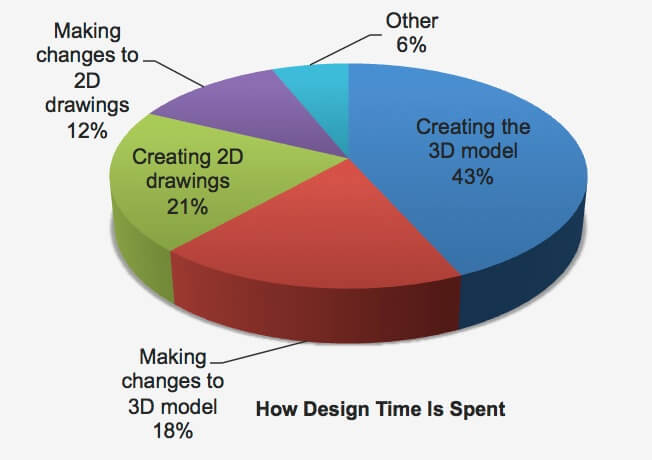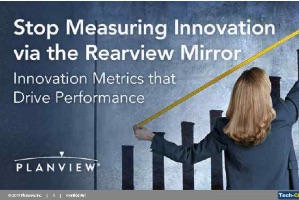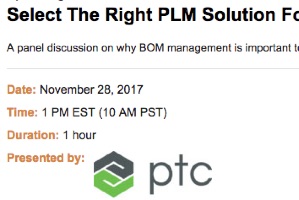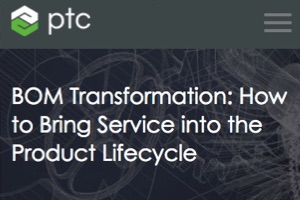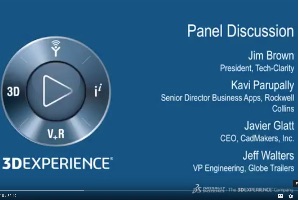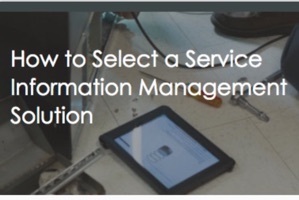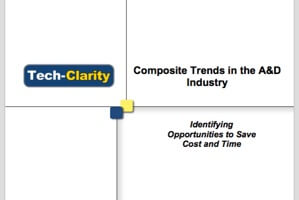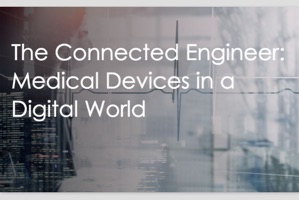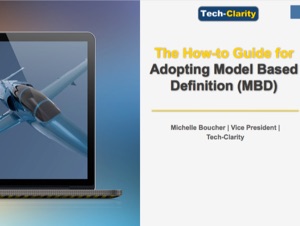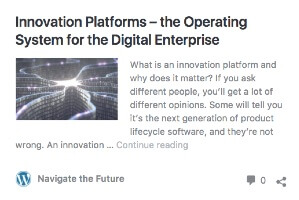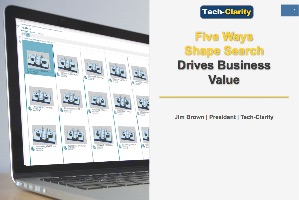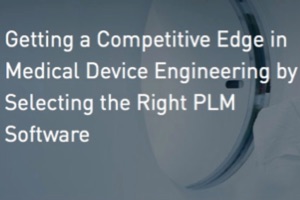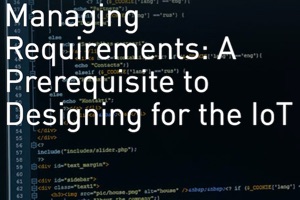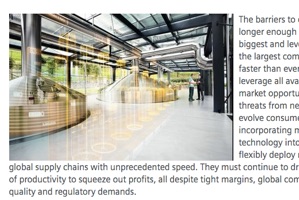Join Tech-Clarity’s Jim Brown in a lively discussion with Planview NPD Evangelist Carrie Nauyalis discussing how to effectively measure product innovation. The duo will discuss the pitfalls of measuring innovation based on prior performance, the top five measures companies can use to measure innovation capability, and what’s needed to get started measuring innovation to improve outcomes….
- Software Requirements (functionality)
- Service Needs (including adoption and training)
- Vendor Attributes
- Special Considerations
 You can also register for a November 28 European webcast at 8:00 AM Eastern featuring PDM Vision Group's Jonas Härdner, Graham Birch, and Jim Brown.
This webcast is free of charge, registration required. Sponsored by PTC.
[post_title] => Select the Right PLM Solution for BOM Management (webcast)
[post_excerpt] =>
[post_status] => publish
[comment_status] => open
[ping_status] => open
[post_password] =>
[post_name] => bom-webcast
[to_ping] =>
[pinged] =>
[post_modified] => 2022-11-14 22:26:53
[post_modified_gmt] => 2022-11-15 03:26:53
[post_content_filtered] =>
[post_parent] => 0
[guid] => http://tech-clarity.com/?p=6458
[menu_order] => 0
[post_type] => post
[post_mime_type] =>
[comment_count] => 0
[filter] => raw
)
[2] => WP_Post Object
(
[ID] => 6444
[post_author] => 2572
[post_date] => 2017-11-20 09:47:46
[post_date_gmt] => 2017-11-20 14:47:46
[post_content] =>
You can also register for a November 28 European webcast at 8:00 AM Eastern featuring PDM Vision Group's Jonas Härdner, Graham Birch, and Jim Brown.
This webcast is free of charge, registration required. Sponsored by PTC.
[post_title] => Select the Right PLM Solution for BOM Management (webcast)
[post_excerpt] =>
[post_status] => publish
[comment_status] => open
[ping_status] => open
[post_password] =>
[post_name] => bom-webcast
[to_ping] =>
[pinged] =>
[post_modified] => 2022-11-14 22:26:53
[post_modified_gmt] => 2022-11-15 03:26:53
[post_content_filtered] =>
[post_parent] => 0
[guid] => http://tech-clarity.com/?p=6458
[menu_order] => 0
[post_type] => post
[post_mime_type] =>
[comment_count] => 0
[filter] => raw
)
[2] => WP_Post Object
(
[ID] => 6444
[post_author] => 2572
[post_date] => 2017-11-20 09:47:46
[post_date_gmt] => 2017-11-20 14:47:46
[post_content] => Listen to Christopher Rösner, General Requirements Manager at e.GO mobile AG, Tech-Clarity's Michelle Boucher, and Che Curnew, Senior Technical Sales Specialist at PTC discuss the benefits of a better approach to requirements management. This event is an interactive interview to share different perspectives and experiences on requirements management. The discussion includes topics such as:
- How a Requirements Management solution can help your business
- How to identify specific requirements needs
- How to select the right solution for your organization
 [post_title] => Selecting the Right Requirements Management Solution (webcast)
[post_excerpt] =>
[post_status] => publish
[comment_status] => open
[ping_status] => open
[post_password] =>
[post_name] => requirements-management-interview
[to_ping] =>
[pinged] =>
[post_modified] => 2022-11-14 22:26:53
[post_modified_gmt] => 2022-11-15 03:26:53
[post_content_filtered] =>
[post_parent] => 0
[guid] => http://tech-clarity.com/?p=6444
[menu_order] => 0
[post_type] => post
[post_mime_type] =>
[comment_count] => 0
[filter] => raw
)
[3] => WP_Post Object
(
[ID] => 6431
[post_author] => 2572
[post_date] => 2017-11-12 23:42:24
[post_date_gmt] => 2017-11-13 04:42:24
[post_content] =>
[post_title] => Selecting the Right Requirements Management Solution (webcast)
[post_excerpt] =>
[post_status] => publish
[comment_status] => open
[ping_status] => open
[post_password] =>
[post_name] => requirements-management-interview
[to_ping] =>
[pinged] =>
[post_modified] => 2022-11-14 22:26:53
[post_modified_gmt] => 2022-11-15 03:26:53
[post_content_filtered] =>
[post_parent] => 0
[guid] => http://tech-clarity.com/?p=6444
[menu_order] => 0
[post_type] => post
[post_mime_type] =>
[comment_count] => 0
[filter] => raw
)
[3] => WP_Post Object
(
[ID] => 6431
[post_author] => 2572
[post_date] => 2017-11-12 23:42:24
[post_date_gmt] => 2017-11-13 04:42:24
[post_content] => Listen to Airbus Helicopters’ Nicolas De Mauroy, PTC's Service Practice Lead Keith Garguilo, and Tech-Clarity's Michelle Boucher, discuss how to improve the quality of the information made to service technicians by using the engineering BOM to produce the service BOM. By watching this event, you will learn about:
- The capabilities needed to transform EBOMs into SBOMs.
- Service BOMs’ impact on field service productivity and service supply chain effectiveness.
- How Airbus used SBOMs to apply full-circle product lifecycle management across its H160 program.
 [post_title] => BOM Transformation: How to Bring Service in to the Product Lifecycle (webcast)
[post_excerpt] =>
[post_status] => publish
[comment_status] => open
[ping_status] => open
[post_password] =>
[post_name] => service-bom
[to_ping] =>
[pinged] =>
[post_modified] => 2022-11-14 22:26:51
[post_modified_gmt] => 2022-11-15 03:26:51
[post_content_filtered] =>
[post_parent] => 0
[guid] => http://tech-clarity.com/?p=6431
[menu_order] => 0
[post_type] => post
[post_mime_type] =>
[comment_count] => 0
[filter] => raw
)
[4] => WP_Post Object
(
[ID] => 6423
[post_author] => 2572
[post_date] => 2017-11-02 14:55:35
[post_date_gmt] => 2017-11-02 18:55:35
[post_content] =>
[post_title] => BOM Transformation: How to Bring Service in to the Product Lifecycle (webcast)
[post_excerpt] =>
[post_status] => publish
[comment_status] => open
[ping_status] => open
[post_password] =>
[post_name] => service-bom
[to_ping] =>
[pinged] =>
[post_modified] => 2022-11-14 22:26:51
[post_modified_gmt] => 2022-11-15 03:26:51
[post_content_filtered] =>
[post_parent] => 0
[guid] => http://tech-clarity.com/?p=6431
[menu_order] => 0
[post_type] => post
[post_mime_type] =>
[comment_count] => 0
[filter] => raw
)
[4] => WP_Post Object
(
[ID] => 6423
[post_author] => 2572
[post_date] => 2017-11-02 14:55:35
[post_date_gmt] => 2017-11-02 18:55:35
[post_content] =>
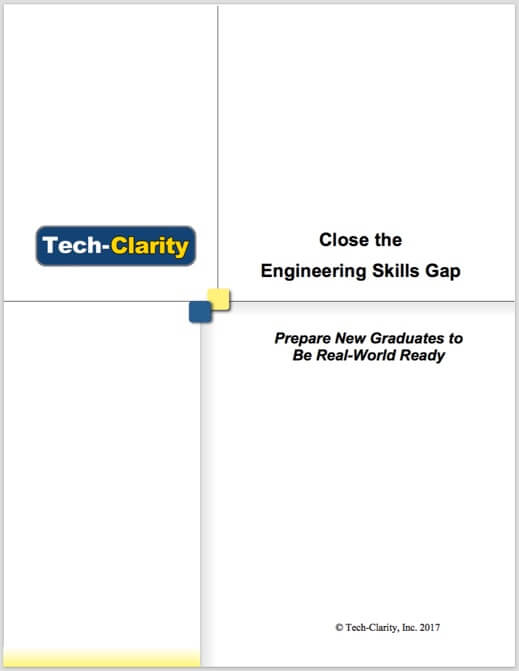 Close the Engineering Skills Gap:Prepare New Graduates to Be Real-World Ready shares new research on the gap between the skills graduating engineers have and skills companies would like to see. The research examines the evolving needs of the engineering department. The results reveal that engineering departments expect to grow so we will need more engineers. On top of that, the required skills will also expand. Complicating the situation, as the most experienced engineers approach retirement age, companies must figure out how to replace that knowledge. This makes the skills of new engineers especially critical. The study identifies these needed skills. It also reveals the types of program that give new graduates the experience hiring managers want to see.
Please enjoy the summary below, or click the report to download a PDF overview (free of charge, no registration required) thanks to our sponsor Siemens PLM.
For more information, please visit the Siemens PLM Community blog to read Engineering our way out of the skills gap.
Close the Engineering Skills Gap:Prepare New Graduates to Be Real-World Ready shares new research on the gap between the skills graduating engineers have and skills companies would like to see. The research examines the evolving needs of the engineering department. The results reveal that engineering departments expect to grow so we will need more engineers. On top of that, the required skills will also expand. Complicating the situation, as the most experienced engineers approach retirement age, companies must figure out how to replace that knowledge. This makes the skills of new engineers especially critical. The study identifies these needed skills. It also reveals the types of program that give new graduates the experience hiring managers want to see.
Please enjoy the summary below, or click the report to download a PDF overview (free of charge, no registration required) thanks to our sponsor Siemens PLM.
For more information, please visit the Siemens PLM Community blog to read Engineering our way out of the skills gap.
Executive Overview
As globalization trends make it that much harder to stand out in today’s competitive environment, companies must rely even more on innovation to engineer winning products that will stand out, capture market share, and secure future revenue streams. Unfortunately, shortages in engineering talent with the right skills make this a challenge. A majority of companies (69%) project their engineering department will need to grow over the next five to ten years. Complicating this further, many of the engineers in the largest segment of the engineering workforce, those with over 20 years of experience, will approach retirement soon. As they leave the workforce, it will put even more pressure on hiring strategies to recruit new engineers. Tech-Clarity research finds that an overwhelming 80% of companies indicate that hiring the right engineers will be either highly or very critical to the future success of their business. Underscoring why it is so critical, 98% of companies report there will be a negative business impact if they can not find and hire the right engineers. These impacts range from loss of competitiveness, poor innovation, higher costs, to lost revenue. Unfortunately, the top challenge of managing the engineering workforce is finding engineering staff with the right skills. Part of the problem is due to the gap between the skills new engineering graduates have and what industry needs. This situation creates a sense of urgency to improve how engineers are prepared during their schooling so that we can close the skills gap. To identify these gaps, Tech-Clarity conducted a global survey of 201 companies. Respondents represented companies of different sizes, across a wide variety of industries, and multiple geographic regions. The results show that manufacturers have a clear preference for how to prepare engineering students for the real-world. They favor students with in-depth project experience involving multiple roles, complete lifecycle stages, and simulate a corporate environment. Schools that incorporate this type of experience into their engineering curriculum will have an advantage as there should be more demand for their graduates in the workforce. Industry would like to see new graduates better prepared to use several skills. Engineering software is very prevalent on this list. This is largely because most companies (75%) want students to be able to apply the technology to solve problems, not just know the “picks and clicks” of the software. The research also finds that industry needs to be more involved in academia to close the skills gap. Interestingly, companies report they are not as engaged as they expect others to be. To close the skills gap, engineering companies should at least double their current involvement with academia. This report identifies the top skills that create the engineering skills gap. The report further explores the types of academic programs and experiences that provide students with the right skills they need to be successful in industry.Table of Contents
- Executive Overview
- State of the Engineering Department
- Impact of the Engineering Shortage
- Identifying the Top Performers
- Look for the Right Engineering Skills
- Consider Programs that Offer Real World Experience
- Develop a Good Hiring Strategy
- Get Involved in the Engineering Curriculum
- Conclusion
- Recommendations
- About the Author
- About the Research
- Copyright Notice
Recommendations
Based on industry experience and research for this report, Tech-Clarity offers the following recommendations:- Invest in your engineering staff to support growth and ensure you can recover from the loss of experienced staff to retirement
- Ensure you have the right mix of engineering talent to support the development of products that involve multiple engineering disciplines
- Hire from engineering programs that go beyond just learning theory and software menu picks, but provide opportunities to apply technology to solve problems
- Work with engineering schools to help them develop the curriculum that will develop the skills you would like to see in new hires
- Look at programs that offer students the opportunities to work on team-based projects, similar to the type of work they will do when employed
- Get involved in engineering programs to ensure enough industry exposure during schooling and develop an exceptional pool of talent to hire from
 [post_title] => How to Beat Your Competition in Product Development (infographic)
[post_excerpt] =>
[post_status] => publish
[comment_status] => open
[ping_status] => open
[post_password] =>
[post_name] => npdi-infographic
[to_ping] =>
[pinged] =>
[post_modified] => 2022-11-14 22:26:07
[post_modified_gmt] => 2022-11-15 03:26:07
[post_content_filtered] =>
[post_parent] => 0
[guid] => http://tech-clarity.com/?p=6413
[menu_order] => 0
[post_type] => post
[post_mime_type] =>
[comment_count] => 7
[filter] => raw
)
[6] => WP_Post Object
(
[ID] => 6407
[post_author] => 2
[post_date] => 2017-10-30 15:54:03
[post_date_gmt] => 2017-10-30 19:54:03
[post_content] => Tech-Clarity's Jim Brown hosted a panel discussion at the recent Dassault Systèmes 3DEXPERIENCE Forum in Florida. The participants shared their perspectives on the cloud and their experience moving PLM to the cloud using the 3DEXPERIENCE Platform. Participants include:
[post_title] => How to Beat Your Competition in Product Development (infographic)
[post_excerpt] =>
[post_status] => publish
[comment_status] => open
[ping_status] => open
[post_password] =>
[post_name] => npdi-infographic
[to_ping] =>
[pinged] =>
[post_modified] => 2022-11-14 22:26:07
[post_modified_gmt] => 2022-11-15 03:26:07
[post_content_filtered] =>
[post_parent] => 0
[guid] => http://tech-clarity.com/?p=6413
[menu_order] => 0
[post_type] => post
[post_mime_type] =>
[comment_count] => 7
[filter] => raw
)
[6] => WP_Post Object
(
[ID] => 6407
[post_author] => 2
[post_date] => 2017-10-30 15:54:03
[post_date_gmt] => 2017-10-30 19:54:03
[post_content] => Tech-Clarity's Jim Brown hosted a panel discussion at the recent Dassault Systèmes 3DEXPERIENCE Forum in Florida. The participants shared their perspectives on the cloud and their experience moving PLM to the cloud using the 3DEXPERIENCE Platform. Participants include:
- Kavi Parupally, Senior Director of Business Apps, Rockwell Collins
- Javier Glatt, CEO, CADMakers, Inc.
- Jeff Walters, VP Engineering, Globe Trailers
 [post_title] => Selecting a Solution to Manage Service Information (guest post)
[post_excerpt] =>
[post_status] => publish
[comment_status] => open
[ping_status] => open
[post_password] =>
[post_name] => selecting-service-information-management-solution
[to_ping] =>
[pinged] =>
[post_modified] => 2022-11-14 22:25:33
[post_modified_gmt] => 2022-11-15 03:25:33
[post_content_filtered] =>
[post_parent] => 0
[guid] => http://tech-clarity.com/?p=6380
[menu_order] => 0
[post_type] => post
[post_mime_type] =>
[comment_count] => 0
[filter] => raw
)
[8] => WP_Post Object
(
[ID] => 6391
[post_author] => 2
[post_date] => 2017-10-24 11:16:11
[post_date_gmt] => 2017-10-24 15:16:11
[post_content] => Jim Brown provided a guest post to the Siemens PLM Community blog discussing how analytics can unlock new value for CPG and Food & Beverage companies. The post shares how big data analytics can uncover hidden relationships and create valuable insights from the vast amounts of data available to today's food companies. It offers examples of how companies can develop product intelligence, create production / process intelligence, and pursue more advanced initiatives to turn information into a competitive weapon.
This is the last of several posts that drill down on Surviving the New Competitive Landscape in Food and Beverage, a post that shares three ways that consumer packaged goods (CPG) companies can start their digitalization journey and how the digital enterprise can help them avoid industry disruption.
The full post, The Analytics Opportunity for Food and Beverages in the Digital Age can be found on the Siemens PLM blog (free of charge, no registration required).
[post_title] => Selecting a Solution to Manage Service Information (guest post)
[post_excerpt] =>
[post_status] => publish
[comment_status] => open
[ping_status] => open
[post_password] =>
[post_name] => selecting-service-information-management-solution
[to_ping] =>
[pinged] =>
[post_modified] => 2022-11-14 22:25:33
[post_modified_gmt] => 2022-11-15 03:25:33
[post_content_filtered] =>
[post_parent] => 0
[guid] => http://tech-clarity.com/?p=6380
[menu_order] => 0
[post_type] => post
[post_mime_type] =>
[comment_count] => 0
[filter] => raw
)
[8] => WP_Post Object
(
[ID] => 6391
[post_author] => 2
[post_date] => 2017-10-24 11:16:11
[post_date_gmt] => 2017-10-24 15:16:11
[post_content] => Jim Brown provided a guest post to the Siemens PLM Community blog discussing how analytics can unlock new value for CPG and Food & Beverage companies. The post shares how big data analytics can uncover hidden relationships and create valuable insights from the vast amounts of data available to today's food companies. It offers examples of how companies can develop product intelligence, create production / process intelligence, and pursue more advanced initiatives to turn information into a competitive weapon.
This is the last of several posts that drill down on Surviving the New Competitive Landscape in Food and Beverage, a post that shares three ways that consumer packaged goods (CPG) companies can start their digitalization journey and how the digital enterprise can help them avoid industry disruption.
The full post, The Analytics Opportunity for Food and Beverages in the Digital Age can be found on the Siemens PLM blog (free of charge, no registration required).
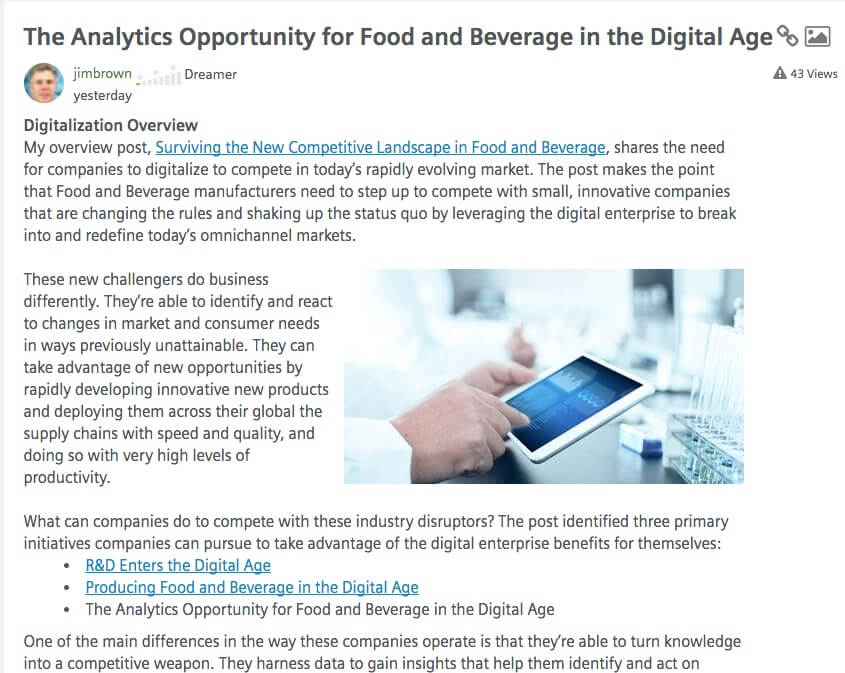 [post_title] => Analytics for Food and Beverage in the Digital Age (guest post)
[post_excerpt] =>
[post_status] => publish
[comment_status] => open
[ping_status] => open
[post_password] =>
[post_name] => dig-analytics
[to_ping] =>
[pinged] =>
[post_modified] => 2022-11-14 22:25:35
[post_modified_gmt] => 2022-11-15 03:25:35
[post_content_filtered] =>
[post_parent] => 0
[guid] => http://tech-clarity.com/?p=6391
[menu_order] => 0
[post_type] => post
[post_mime_type] =>
[comment_count] => 0
[filter] => raw
)
[9] => WP_Post Object
(
[ID] => 6159
[post_author] => 2572
[post_date] => 2017-10-23 11:30:05
[post_date_gmt] => 2017-10-23 15:30:05
[post_content] =>
[post_title] => Analytics for Food and Beverage in the Digital Age (guest post)
[post_excerpt] =>
[post_status] => publish
[comment_status] => open
[ping_status] => open
[post_password] =>
[post_name] => dig-analytics
[to_ping] =>
[pinged] =>
[post_modified] => 2022-11-14 22:25:35
[post_modified_gmt] => 2022-11-15 03:25:35
[post_content_filtered] =>
[post_parent] => 0
[guid] => http://tech-clarity.com/?p=6391
[menu_order] => 0
[post_type] => post
[post_mime_type] =>
[comment_count] => 0
[filter] => raw
)
[9] => WP_Post Object
(
[ID] => 6159
[post_author] => 2572
[post_date] => 2017-10-23 11:30:05
[post_date_gmt] => 2017-10-23 15:30:05
[post_content] => 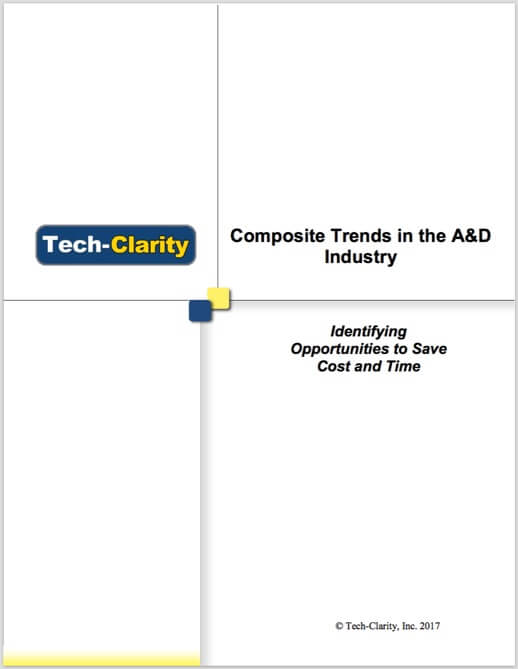 Composite Trends in the A&D Industry: Identifying Opportunities to Save Cost and Time reveals survey findings on design and manufacturing trends for composites in the Aerospace & Defense industry. The research examines two areas that can be a source for bottlenecks when working with composites: springback and manufacturing planning. The report details best practices to minimize or avoid distortions due to springback. It also looks at ways to streamline manufacturing planning while reducing errors and supporting changing.
Please enjoy the summary below, or click the report to download a PDF overview (free of charge, no registration required) thanks to our sponsor Siemens PLM.
Composite Trends in the A&D Industry: Identifying Opportunities to Save Cost and Time reveals survey findings on design and manufacturing trends for composites in the Aerospace & Defense industry. The research examines two areas that can be a source for bottlenecks when working with composites: springback and manufacturing planning. The report details best practices to minimize or avoid distortions due to springback. It also looks at ways to streamline manufacturing planning while reducing errors and supporting changing.
Please enjoy the summary below, or click the report to download a PDF overview (free of charge, no registration required) thanks to our sponsor Siemens PLM.
Executive Overview
Composites have become increasingly important to the Aerospace and Defense (A&D) industry. In fact, Tech-Clarity’s Composite State of the Market study, found that A&D companies overwhelmingly turn to composites to help with light weighting so that they can improve performance and realize better fuel economy. The study also found that while composites offer significant benefits, the expense of the material means companies should look at ways to get better insight. This way they can make better decisions during design to produce better composite parts. This is especially important to the A&D industry, which is under significant pressure to manage costs. To further examine the use of composites in the A&D industry, Tech-Clarity surveyed 181 A&D manufacturers. The study examines two areas that can be a source for bottlenecks when working with composites: springback and manufacturing planning. Springback can cause significant issues for A&D companies. Springback is a manufacturing defect that can occur while the composite part is curing. Due to shrinkage, the material can deviate from the original molded shape. When this happens, the part is out of tolerance. Depending on how severe the distortion is, manufacturers have to spend extra time correcting the part to get it within tolerance so that they can assemble it. In a worst case scenario, they may even have to scrap the part. This results in a lot of wasted time and excess cost. The good news is that companies who have adopted best practices for composites are much less likely to experience springback. One of those best practices includes using design guidelines. Another best practice involves communicating ply level design information by providing direct access to the composite data in the engineering model. Manufacturing planning is another important part of producing quality composite parts. With composites, it is especially crucial to produce parts exactly as designed. Even a slight deviation in fiber orientation significantly impacts part strength. By following manufacturing planning best practices you are more likely to produce composite parts as-designed. Best practices involve leveraging an accurate engineering model. In addition, manufacturers should look at ways to automate changes to avoid wasted time manually reworking manufacturing plans. This report examines design and manufacturing trends in the use of composites in the A&D industry. It also offers advice to overcome common problems to help A&D companies lower costTable of Contents
- Executive Overview
- Understanding Springback
- Corrective Actions for Springback
- Identifying the Top Performers
- Avoiding Springback
- Planning for Manufacturing
- Don’t Overlook the Time Impact of Changes
- Considering Programming Trends
- Conclusion
- Recommendations
- About the Author
- About the Research
- Copyright Notice
Conclusion
Many A&D companies have turned to composites to help them improve performance and realize better fuel economy. However, the A&D industry is also under significant pressure to lower costs. Addressing manufacturing defects such as springback as well as better manufacturing planning can help A&D companies take advantage of the benefits of composites while improving design and production efficiency and lowering costs. Springback can be a considerable source of excess cost and waste. Typically, springback causes parts to be out of tolerance so manufactures have to waste time correcting parts, or worse, scrapping them. By adopting best practices, such as using design guidelines, A&D manufacturers can avoid springback. Adopting best practices for manufacturing planning is another area where A&D manufacturers can improve quality. It is crucial that composite parts are manufactured as designed to ensure performance. By adopting practices such as leveraging the engineering composite model for manufacturing planning and automating changes, A&D manufacturers will be better positioned to produce parts as designed without quality issues.Recommendations
Based on industry experience and research for this report, Tech-Clarity offers the following recommendations:- To avoid springback, focus of identify potential occurrences during design
- Take advantage of design guidelines to help avoid springback.
- Consider solutions that offer embedded intelligence to provide guidance and support better decision to reduce the occurrence of springback.
- Communicate ply level design data to manufacturing via the engineering model
 [post_title] => Medical Devices in a Digital World (podcast)
[post_excerpt] =>
[post_status] => publish
[comment_status] => open
[ping_status] => open
[post_password] =>
[post_name] => medical-devices-podcast
[to_ping] =>
[pinged] =>
[post_modified] => 2022-12-02 15:34:39
[post_modified_gmt] => 2022-12-02 20:34:39
[post_content_filtered] =>
[post_parent] => 0
[guid] => http://tech-clarity.com/?p=6364
[menu_order] => 0
[post_type] => post
[post_mime_type] =>
[comment_count] => 0
[filter] => raw
)
[11] => WP_Post Object
(
[ID] => 6343
[post_author] => 2572
[post_date] => 2017-10-17 11:30:30
[post_date_gmt] => 2017-10-17 15:30:30
[post_content] =>
[post_title] => Medical Devices in a Digital World (podcast)
[post_excerpt] =>
[post_status] => publish
[comment_status] => open
[ping_status] => open
[post_password] =>
[post_name] => medical-devices-podcast
[to_ping] =>
[pinged] =>
[post_modified] => 2022-12-02 15:34:39
[post_modified_gmt] => 2022-12-02 20:34:39
[post_content_filtered] =>
[post_parent] => 0
[guid] => http://tech-clarity.com/?p=6364
[menu_order] => 0
[post_type] => post
[post_mime_type] =>
[comment_count] => 0
[filter] => raw
)
[11] => WP_Post Object
(
[ID] => 6343
[post_author] => 2572
[post_date] => 2017-10-17 11:30:30
[post_date_gmt] => 2017-10-17 15:30:30
[post_content] => 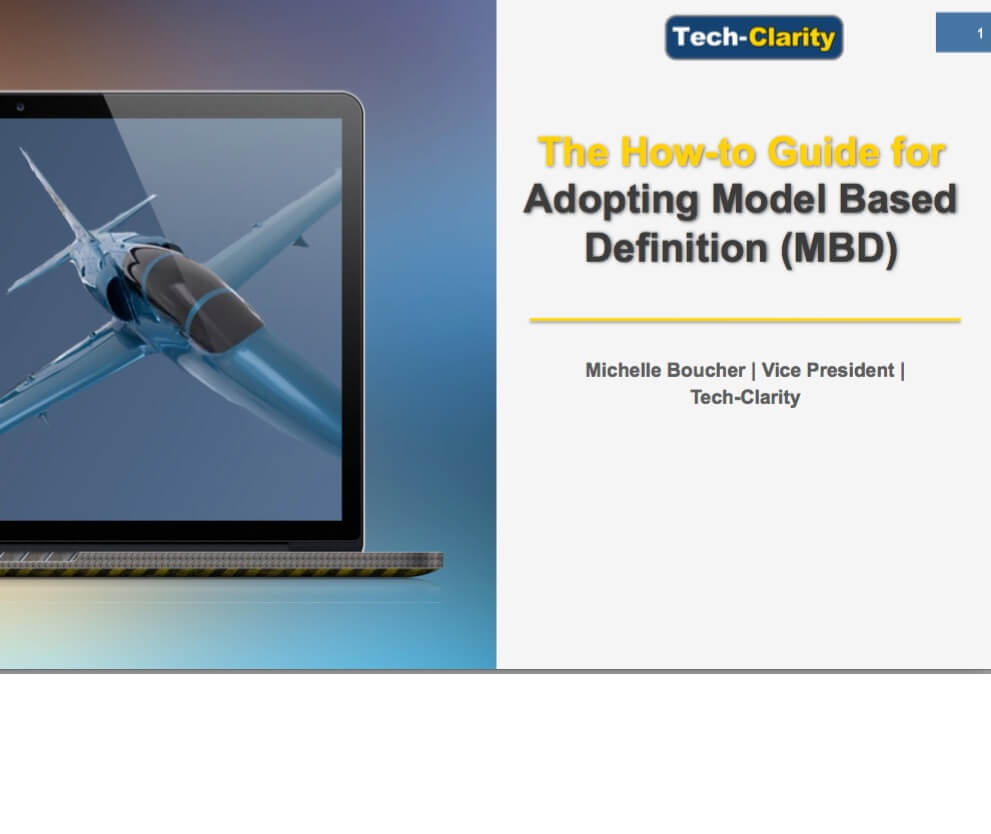 The How-to Guide for Adopting Model Based Definition (MBD) reveals advice and best practices for implementing MBD. The guide explains why 89% of companies are happy they made the transition and benefits they enjoy as a result. The hardest part of adopting MBD is overcoming the cultural resistance to change. The guide identifies what other companies have done to make the adoption of MBD a success, both internally and with suppliers.
This eBook is one in a series of three:
The How-to Guide for Adopting Model Based Definition (MBD) reveals advice and best practices for implementing MBD. The guide explains why 89% of companies are happy they made the transition and benefits they enjoy as a result. The hardest part of adopting MBD is overcoming the cultural resistance to change. The guide identifies what other companies have done to make the adoption of MBD a success, both internally and with suppliers.
This eBook is one in a series of three:
- Transitioning from 2D CAD to 3D CAD
- Migrating from 3D CAD to a new 3D CAD
- Adopting model-based definition (MBD)
Why Consider Model-Based Definition?
With fierce global competition, today's manufacturers have to work harder than ever to stay competitive. While time-to-market used to be the dominant pressure, Tech-Clarity's research shows that now cost and quality are equally pressing, with innovation and performance not far behind. With so many different pressures, engineers have their work cut out for them. Constant time-to-market pressures make it hard to look for ways to cut cost while improving quality. They desperately need to improve efficiency so that they have the bandwidth to accomplish all of this. Tech-Clarity discovered that 33 percent of design time is spent on drawings. Considering this mostly involves documenting what is already in the 3D model, that is a lot of time wasted on non-value-added efforts. Opportunities for improvement are significant. This is where model-based definition (MBD) comes in.What Is Driving MBD Adoption?
Initially, companies were most likely to adopt MBD to improve communication with manufacturing and suppliers. Compared to a 2D drawing, a 3D model makes it easier to visualize the final product. Plus, there is far less room for misinterpretation for things like assembly procedures. Also, in an effort to adopt more environmentally friendly policies as well as reduce costs, many companies turned to MBD as a way to reduce paper. These are still important drivers, but companies who are currently considering adopting MBD are looking at it more as a way to make better use of engineering time. By reducing all that time spent creating 2D drawings, engineers can focus more effort on value-added tasks that will improve the design and result in products that are more competitive.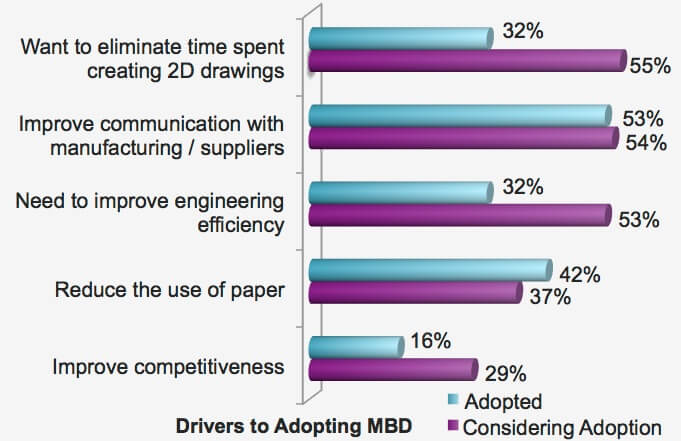 *This summary is an abbreviated version of the report and does not contain the full content. A link to download the full report is available above. If you have difficulty obtaining a copy of the report, please contact us using the "Contact" link below.
[post_title] => The How-to Guide for Adopting Model Based Definition (MBD)
[post_excerpt] =>
[post_status] => publish
[comment_status] => open
[ping_status] => open
[post_password] =>
[post_name] => adopting-model-based-definition-mbd
[to_ping] =>
[pinged] =>
[post_modified] => 2023-12-15 13:40:30
[post_modified_gmt] => 2023-12-15 18:40:30
[post_content_filtered] =>
[post_parent] => 0
[guid] => http://tech-clarity.com/?p=6343
[menu_order] => 0
[post_type] => post
[post_mime_type] =>
[comment_count] => 0
[filter] => raw
)
[12] => WP_Post Object
(
[ID] => 6330
[post_author] => 2
[post_date] => 2017-10-03 14:45:17
[post_date_gmt] => 2017-10-03 18:45:17
[post_content] => Jim Brown contributed a guest post to the Siemens PLM Community blog discussing how digitalization impacts the production of consumer packaged goods such as food and beverages. Digital enterprise in the food and beverage industry opens up a number of opportunities to improve manufacturing productivity and agility, all while maintaining or improving cost and quality. The post discusses benefits available from using digital approaches to design and validate products, production lines, and plants and operate them at very high levels of efficiency.
This is the third of several posts that drill down on Surviving the New Competitive Landscape in Food and Beverage, a post that shares three ways that consumer packaged goods (CPG) companies can start their digitalization journey and how the digital enterprise can help them avoid industry disruption.
The full post, Producing Food and Beverages in the Digital Age can be found on the Siemens PLM blog (free of charge, no registration required).
*This summary is an abbreviated version of the report and does not contain the full content. A link to download the full report is available above. If you have difficulty obtaining a copy of the report, please contact us using the "Contact" link below.
[post_title] => The How-to Guide for Adopting Model Based Definition (MBD)
[post_excerpt] =>
[post_status] => publish
[comment_status] => open
[ping_status] => open
[post_password] =>
[post_name] => adopting-model-based-definition-mbd
[to_ping] =>
[pinged] =>
[post_modified] => 2023-12-15 13:40:30
[post_modified_gmt] => 2023-12-15 18:40:30
[post_content_filtered] =>
[post_parent] => 0
[guid] => http://tech-clarity.com/?p=6343
[menu_order] => 0
[post_type] => post
[post_mime_type] =>
[comment_count] => 0
[filter] => raw
)
[12] => WP_Post Object
(
[ID] => 6330
[post_author] => 2
[post_date] => 2017-10-03 14:45:17
[post_date_gmt] => 2017-10-03 18:45:17
[post_content] => Jim Brown contributed a guest post to the Siemens PLM Community blog discussing how digitalization impacts the production of consumer packaged goods such as food and beverages. Digital enterprise in the food and beverage industry opens up a number of opportunities to improve manufacturing productivity and agility, all while maintaining or improving cost and quality. The post discusses benefits available from using digital approaches to design and validate products, production lines, and plants and operate them at very high levels of efficiency.
This is the third of several posts that drill down on Surviving the New Competitive Landscape in Food and Beverage, a post that shares three ways that consumer packaged goods (CPG) companies can start their digitalization journey and how the digital enterprise can help them avoid industry disruption.
The full post, Producing Food and Beverages in the Digital Age can be found on the Siemens PLM blog (free of charge, no registration required).
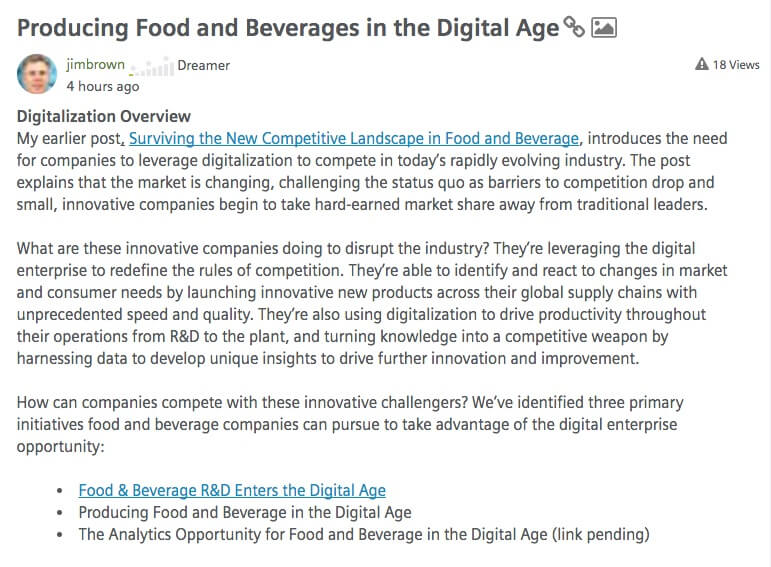 [post_title] => Producing Food and Beverages in the Digital Age (guest post)
[post_excerpt] =>
[post_status] => publish
[comment_status] => open
[ping_status] => open
[post_password] =>
[post_name] => dig-mfg
[to_ping] =>
[pinged] =>
[post_modified] => 2022-11-14 22:25:33
[post_modified_gmt] => 2022-11-15 03:25:33
[post_content_filtered] =>
[post_parent] => 0
[guid] => http://tech-clarity.com/?p=6330
[menu_order] => 0
[post_type] => post
[post_mime_type] =>
[comment_count] => 0
[filter] => raw
)
[13] => WP_Post Object
(
[ID] => 6319
[post_author] => 2
[post_date] => 2017-09-28 16:15:09
[post_date_gmt] => 2017-09-28 20:15:09
[post_content] => This infographic shares survey results about quality and cost management in the Consumer Packaged Goods industry. It visually communicates the results of our research that shows how Top Performing CPG companies are able to achieve better quality and better cost of quality, without trading one for the other. The research shares the methods these leading companies employ, including automation, integration, and a more holistic approach to managing quality.
[post_title] => Producing Food and Beverages in the Digital Age (guest post)
[post_excerpt] =>
[post_status] => publish
[comment_status] => open
[ping_status] => open
[post_password] =>
[post_name] => dig-mfg
[to_ping] =>
[pinged] =>
[post_modified] => 2022-11-14 22:25:33
[post_modified_gmt] => 2022-11-15 03:25:33
[post_content_filtered] =>
[post_parent] => 0
[guid] => http://tech-clarity.com/?p=6330
[menu_order] => 0
[post_type] => post
[post_mime_type] =>
[comment_count] => 0
[filter] => raw
)
[13] => WP_Post Object
(
[ID] => 6319
[post_author] => 2
[post_date] => 2017-09-28 16:15:09
[post_date_gmt] => 2017-09-28 20:15:09
[post_content] => This infographic shares survey results about quality and cost management in the Consumer Packaged Goods industry. It visually communicates the results of our research that shows how Top Performing CPG companies are able to achieve better quality and better cost of quality, without trading one for the other. The research shares the methods these leading companies employ, including automation, integration, and a more holistic approach to managing quality.
 To learn more, please:
View the full Stop Choosing Between Cost and Quality in CPG infographic from our sponsor Dassault Systèmes BIOVIA (free or charge, registration required).
Download the full Reducing Cost of Quality in CPG report from our sponsor Dassault Systèmes BIOVIA (free or charge, registration required).
See the Reducing Cost of Quality for Consumer Packaged Goods survey report overview from out site (free of charge, no registration required)
To learn more, please:
View the full Stop Choosing Between Cost and Quality in CPG infographic from our sponsor Dassault Systèmes BIOVIA (free or charge, registration required).
Download the full Reducing Cost of Quality in CPG report from our sponsor Dassault Systèmes BIOVIA (free or charge, registration required).
See the Reducing Cost of Quality for Consumer Packaged Goods survey report overview from out site (free of charge, no registration required)
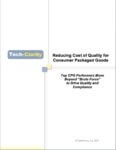 [post_title] => Choosing Cost versus Quality in CPG (infographic)
[post_excerpt] =>
[post_status] => publish
[comment_status] => open
[ping_status] => open
[post_password] =>
[post_name] => quality-cpg
[to_ping] =>
[pinged] =>
[post_modified] => 2022-11-14 22:26:08
[post_modified_gmt] => 2022-11-15 03:26:08
[post_content_filtered] =>
[post_parent] => 0
[guid] => http://tech-clarity.com/?p=6319
[menu_order] => 0
[post_type] => post
[post_mime_type] =>
[comment_count] => 0
[filter] => raw
)
[14] => WP_Post Object
(
[ID] => 6309
[post_author] => 2
[post_date] => 2017-09-26 12:02:56
[post_date_gmt] => 2017-09-26 16:02:56
[post_content] =>
[post_title] => Choosing Cost versus Quality in CPG (infographic)
[post_excerpt] =>
[post_status] => publish
[comment_status] => open
[ping_status] => open
[post_password] =>
[post_name] => quality-cpg
[to_ping] =>
[pinged] =>
[post_modified] => 2022-11-14 22:26:08
[post_modified_gmt] => 2022-11-15 03:26:08
[post_content_filtered] =>
[post_parent] => 0
[guid] => http://tech-clarity.com/?p=6319
[menu_order] => 0
[post_type] => post
[post_mime_type] =>
[comment_count] => 0
[filter] => raw
)
[14] => WP_Post Object
(
[ID] => 6309
[post_author] => 2
[post_date] => 2017-09-26 12:02:56
[post_date_gmt] => 2017-09-26 16:02:56
[post_content] =>  Jim Brown contributed a guest post, Innovation Platforms - the Operating System for the Digital Enterprise, on the value of innovation platforms published in the Dassault Systèmes' Navigate the Future blog. The post shares the value an integrated platform of solutions provides to engineers, the enterprise, and toward achieving digital transformation. The post also covers some basis of the innovation platform from people, process, and technology perspectives.
Read the post now (free of charge, no registration required).
Jim Brown contributed a guest post, Innovation Platforms - the Operating System for the Digital Enterprise, on the value of innovation platforms published in the Dassault Systèmes' Navigate the Future blog. The post shares the value an integrated platform of solutions provides to engineers, the enterprise, and toward achieving digital transformation. The post also covers some basis of the innovation platform from people, process, and technology perspectives.
Read the post now (free of charge, no registration required).
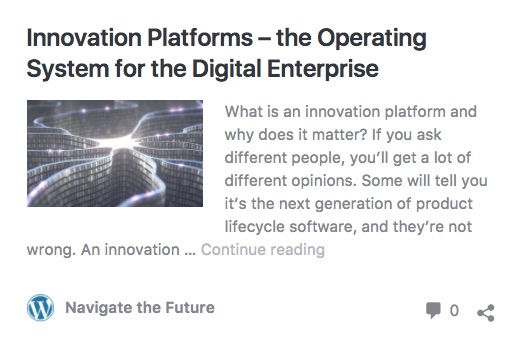 [post_title] => Innovation Platforms are the Operating Systems for the Digital Enterprise (guest post)
[post_excerpt] =>
[post_status] => publish
[comment_status] => open
[ping_status] => open
[post_password] =>
[post_name] => i-platform
[to_ping] =>
[pinged] =>
[post_modified] => 2022-11-14 22:25:35
[post_modified_gmt] => 2022-11-15 03:25:35
[post_content_filtered] =>
[post_parent] => 0
[guid] => http://tech-clarity.com/?p=6309
[menu_order] => 0
[post_type] => post
[post_mime_type] =>
[comment_count] => 0
[filter] => raw
)
[15] => WP_Post Object
(
[ID] => 6298
[post_author] => 2
[post_date] => 2017-09-19 14:25:06
[post_date_gmt] => 2017-09-19 18:25:06
[post_content] =>
[post_title] => Innovation Platforms are the Operating Systems for the Digital Enterprise (guest post)
[post_excerpt] =>
[post_status] => publish
[comment_status] => open
[ping_status] => open
[post_password] =>
[post_name] => i-platform
[to_ping] =>
[pinged] =>
[post_modified] => 2022-11-14 22:25:35
[post_modified_gmt] => 2022-11-15 03:25:35
[post_content_filtered] =>
[post_parent] => 0
[guid] => http://tech-clarity.com/?p=6309
[menu_order] => 0
[post_type] => post
[post_mime_type] =>
[comment_count] => 0
[filter] => raw
)
[15] => WP_Post Object
(
[ID] => 6298
[post_author] => 2
[post_date] => 2017-09-19 14:25:06
[post_date_gmt] => 2017-09-19 18:25:06
[post_content] =>  Five Ways Shape Search Drives Business Value shares the shortcomings of traditional search methodologies and how geometric search can complement them to drive new business value. The report includes some basics about shape search, five tangible ways it can improve business performance, and an example of how to calculate the ROI of a shape search investment.
Click here to view the full PDF, thank you to our sponsor Siemens PLM.
For more information, please visit the Siemens PLM Community blog to read the Shape Search for Engineering Productivity and related blog posts from Erwin Argyle.
Five Ways Shape Search Drives Business Value shares the shortcomings of traditional search methodologies and how geometric search can complement them to drive new business value. The report includes some basics about shape search, five tangible ways it can improve business performance, and an example of how to calculate the ROI of a shape search investment.
Click here to view the full PDF, thank you to our sponsor Siemens PLM.
For more information, please visit the Siemens PLM Community blog to read the Shape Search for Engineering Productivity and related blog posts from Erwin Argyle.
In Search of … Effective Search
Finding engineering data is frustrating. Search consistently shows up in our research as a challenge that leads to inefficiency for engineers and others relying on information to do their jobs.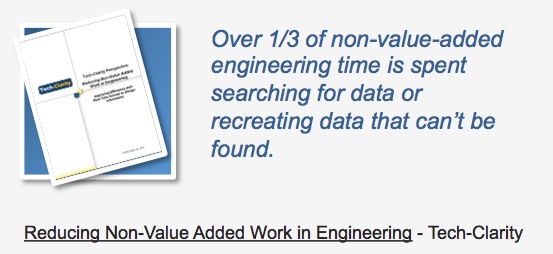 Poor search capabilities are more than just a nuisance, they cost companies time and money. Some may be surprised at not only the number of ways improving search can save money, but how it can positively impact top line revenue. We’ll explore these benefits and then provide a template to quantify the value companies can achieve.
A lot of energy has been put into helping companies find parts. There are multiple strategies and approaches to find parts including keyword, metadata, and semantic search. Another technology that’s reaching the mainstream is geometric search, also known as “shape search.”
These search tools are better when used in combination, and more valuable when coupled with strategies like filtering results. Of course it’s not finding just any part that’s difficult, it’s efficiently finding the part that you need to help you do your job when you need it. Speed is the name of the game for search, and efficient search relies on strategies like advanced indexing to perform quickly enough to be useful. Let’s learn more.
Poor search capabilities are more than just a nuisance, they cost companies time and money. Some may be surprised at not only the number of ways improving search can save money, but how it can positively impact top line revenue. We’ll explore these benefits and then provide a template to quantify the value companies can achieve.
A lot of energy has been put into helping companies find parts. There are multiple strategies and approaches to find parts including keyword, metadata, and semantic search. Another technology that’s reaching the mainstream is geometric search, also known as “shape search.”
These search tools are better when used in combination, and more valuable when coupled with strategies like filtering results. Of course it’s not finding just any part that’s difficult, it’s efficiently finding the part that you need to help you do your job when you need it. Speed is the name of the game for search, and efficient search relies on strategies like advanced indexing to perform quickly enough to be useful. Let’s learn more.
Conclusion
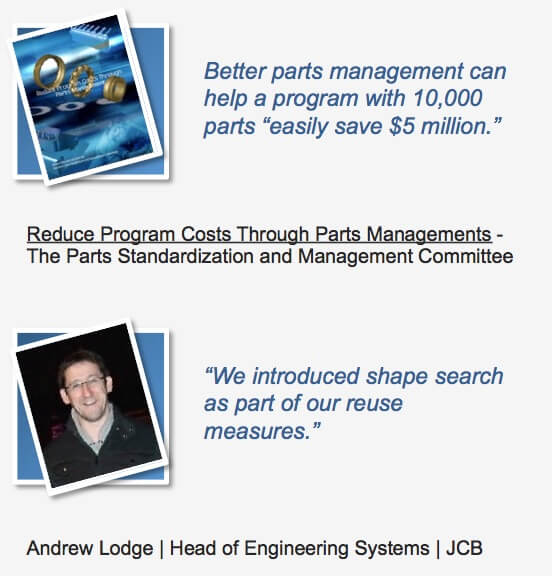 Search is an area that’s ripe for improvement. 3D shape search is a proven technology that can help, and is stronger when combined with other search methods. Shape search is becoming mainstream and more commonly integrated with underlying systems like PLM. It can be fast if indexing is done correctly ahead of time (pay attention here, solutions vary greatly in scalability).
Shape search helps reduce direct cost, but also improves innovation and time to market to drive top-line improvements. Because of the business value of reuse, shape search should be a best practice. It should be built into processes like new part requests to institutionalize it.
One of the biggest objections we hear about shape search is that “it sounds too good to be true.” We recommend that you pilot a solution using your own data to see for yourself.
*This summary is an abbreviated version of the report and does not contain the full content. A link to download the full report is available above.
If you have difficulty obtaining a copy of the report, please contact us using the "Contact" link below.
[post_title] => Five Ways Shape Search Drives Business Value (eBook)
[post_excerpt] =>
[post_status] => publish
[comment_status] => open
[ping_status] => open
[post_password] =>
[post_name] => shape-search
[to_ping] =>
[pinged] =>
[post_modified] => 2022-11-14 22:28:07
[post_modified_gmt] => 2022-11-15 03:28:07
[post_content_filtered] =>
[post_parent] => 0
[guid] => http://tech-clarity.com/?p=6298
[menu_order] => 0
[post_type] => post
[post_mime_type] =>
[comment_count] => 0
[filter] => raw
)
[16] => WP_Post Object
(
[ID] => 6286
[post_author] => 2
[post_date] => 2017-09-12 13:06:02
[post_date_gmt] => 2017-09-12 17:06:02
[post_content] => Jim Brown contributed a guest post to the Siemens PLM Community blog discussing how R&D in the food and beverage industry can step up to the digital age to combat smaller, innovative companies that embrace the digital enterprise. This is the first of several posts that drill down on Surviving the New Competitive Landscape in Food and Beverage, a post that shares three ways that consumer packaged goods (CPG) companies can start their digitalization journey and discusses how that can help them avoid industry disruption.
The first opportunity we're looking into is how the digital enterprise can improve research and development to improve innovation and agility. This is the second in a four-part series of posts on the topic.
The full post, Food and Beverage R&D Enters the Digital Age can be found on the Siemens PLM blog (free of charge, no registration required).
Search is an area that’s ripe for improvement. 3D shape search is a proven technology that can help, and is stronger when combined with other search methods. Shape search is becoming mainstream and more commonly integrated with underlying systems like PLM. It can be fast if indexing is done correctly ahead of time (pay attention here, solutions vary greatly in scalability).
Shape search helps reduce direct cost, but also improves innovation and time to market to drive top-line improvements. Because of the business value of reuse, shape search should be a best practice. It should be built into processes like new part requests to institutionalize it.
One of the biggest objections we hear about shape search is that “it sounds too good to be true.” We recommend that you pilot a solution using your own data to see for yourself.
*This summary is an abbreviated version of the report and does not contain the full content. A link to download the full report is available above.
If you have difficulty obtaining a copy of the report, please contact us using the "Contact" link below.
[post_title] => Five Ways Shape Search Drives Business Value (eBook)
[post_excerpt] =>
[post_status] => publish
[comment_status] => open
[ping_status] => open
[post_password] =>
[post_name] => shape-search
[to_ping] =>
[pinged] =>
[post_modified] => 2022-11-14 22:28:07
[post_modified_gmt] => 2022-11-15 03:28:07
[post_content_filtered] =>
[post_parent] => 0
[guid] => http://tech-clarity.com/?p=6298
[menu_order] => 0
[post_type] => post
[post_mime_type] =>
[comment_count] => 0
[filter] => raw
)
[16] => WP_Post Object
(
[ID] => 6286
[post_author] => 2
[post_date] => 2017-09-12 13:06:02
[post_date_gmt] => 2017-09-12 17:06:02
[post_content] => Jim Brown contributed a guest post to the Siemens PLM Community blog discussing how R&D in the food and beverage industry can step up to the digital age to combat smaller, innovative companies that embrace the digital enterprise. This is the first of several posts that drill down on Surviving the New Competitive Landscape in Food and Beverage, a post that shares three ways that consumer packaged goods (CPG) companies can start their digitalization journey and discusses how that can help them avoid industry disruption.
The first opportunity we're looking into is how the digital enterprise can improve research and development to improve innovation and agility. This is the second in a four-part series of posts on the topic.
The full post, Food and Beverage R&D Enters the Digital Age can be found on the Siemens PLM blog (free of charge, no registration required).
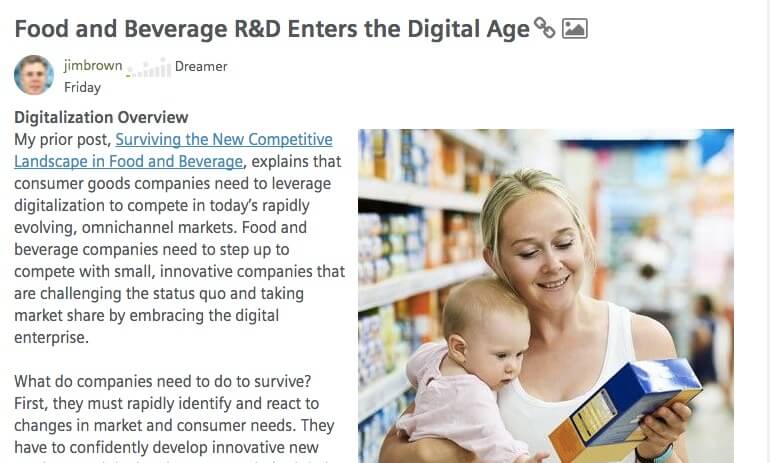 [post_title] => R&D Enters the Digital Age (guest post)
[post_excerpt] =>
[post_status] => publish
[comment_status] => open
[ping_status] => open
[post_password] =>
[post_name] => dig-rd
[to_ping] =>
[pinged] =>
[post_modified] => 2022-11-14 22:25:33
[post_modified_gmt] => 2022-11-15 03:25:33
[post_content_filtered] =>
[post_parent] => 0
[guid] => http://tech-clarity.com/?p=6286
[menu_order] => 0
[post_type] => post
[post_mime_type] =>
[comment_count] => 0
[filter] => raw
)
[17] => WP_Post Object
(
[ID] => 6281
[post_author] => 2572
[post_date] => 2017-09-11 13:22:52
[post_date_gmt] => 2017-09-11 17:22:52
[post_content] =>
[post_title] => R&D Enters the Digital Age (guest post)
[post_excerpt] =>
[post_status] => publish
[comment_status] => open
[ping_status] => open
[post_password] =>
[post_name] => dig-rd
[to_ping] =>
[pinged] =>
[post_modified] => 2022-11-14 22:25:33
[post_modified_gmt] => 2022-11-15 03:25:33
[post_content_filtered] =>
[post_parent] => 0
[guid] => http://tech-clarity.com/?p=6286
[menu_order] => 0
[post_type] => post
[post_mime_type] =>
[comment_count] => 0
[filter] => raw
)
[17] => WP_Post Object
(
[ID] => 6281
[post_author] => 2572
[post_date] => 2017-09-11 13:22:52
[post_date_gmt] => 2017-09-11 17:22:52
[post_content] => Listen to Tech-Clarity's Michelle Boucher, Mark Turner from Alcon Labs (Novartis), and Swapan Jha from PTC have a discussion on the right software solution for medical device engineering. The discussion featured an interactive discussion between the panelists coving topics such as:
- Challenges facing medical device manufacturers.
- Why to consider the complete product lifecycle with respect to:
- Managing product and requirements.
- Transitioning from document to product centric approaches.
- Enabling smart and connected products.
- The best selection criteria for choosing the right software to support quality initiatives.
 [post_title] => Selecting the Right PLM Software for Medical Device Engineering (webcast)
[post_excerpt] =>
[post_status] => publish
[comment_status] => open
[ping_status] => open
[post_password] =>
[post_name] => medical-device-engineering-software
[to_ping] =>
[pinged] =>
[post_modified] => 2022-11-14 22:26:53
[post_modified_gmt] => 2022-11-15 03:26:53
[post_content_filtered] =>
[post_parent] => 0
[guid] => http://tech-clarity.com/?p=6281
[menu_order] => 0
[post_type] => post
[post_mime_type] =>
[comment_count] => 0
[filter] => raw
)
[18] => WP_Post Object
(
[ID] => 6272
[post_author] => 2572
[post_date] => 2017-09-06 11:30:15
[post_date_gmt] => 2017-09-06 15:30:15
[post_content] =>
[post_title] => Selecting the Right PLM Software for Medical Device Engineering (webcast)
[post_excerpt] =>
[post_status] => publish
[comment_status] => open
[ping_status] => open
[post_password] =>
[post_name] => medical-device-engineering-software
[to_ping] =>
[pinged] =>
[post_modified] => 2022-11-14 22:26:53
[post_modified_gmt] => 2022-11-15 03:26:53
[post_content_filtered] =>
[post_parent] => 0
[guid] => http://tech-clarity.com/?p=6281
[menu_order] => 0
[post_type] => post
[post_mime_type] =>
[comment_count] => 0
[filter] => raw
)
[18] => WP_Post Object
(
[ID] => 6272
[post_author] => 2572
[post_date] => 2017-09-06 11:30:15
[post_date_gmt] => 2017-09-06 15:30:15
[post_content] => Listen to Steve Partridge, Sr. Go To Market Solution Specialist for PTC, and Tech-Clarity's Michelle Boucher discuss the benefits of improving how requirements are managed, especially to support your IoT strategy. The discussion includes topics such as:
- How best practices for requirements management provide visibility into design decisions, changes, and tests
- Considerations to manage people, process and technology to make your requirements management process a success
- Suggested criteria to select the right requirements management software to meet your organization’s needs
- How requirements management can get you on the right track to develop smart connected products
 [post_title] => Managing Requirements: A Prerequisite to Designing for the IoT (Webcast)
[post_excerpt] =>
[post_status] => publish
[comment_status] => open
[ping_status] => open
[post_password] =>
[post_name] => managing-requirements-iot
[to_ping] =>
[pinged] =>
[post_modified] => 2022-11-14 22:26:46
[post_modified_gmt] => 2022-11-15 03:26:46
[post_content_filtered] =>
[post_parent] => 0
[guid] => http://tech-clarity.com/?p=6272
[menu_order] => 0
[post_type] => post
[post_mime_type] =>
[comment_count] => 0
[filter] => raw
)
[19] => WP_Post Object
(
[ID] => 6260
[post_author] => 2
[post_date] => 2017-08-23 08:57:44
[post_date_gmt] => 2017-08-23 12:57:44
[post_content] => Jim Brown contributed a guest post to the Siemens PLM Community blog discussing the opportunity for food and beverage companies to leverage digitalization and the digital enterprise to combat market disruption from new, innovate companies that are challenging current industry leaders. The post offers several ways that consumer packaged goods (CPG) companies can get started on their digital journey, achieve tangible business value, and combat challengers like Blue Apron and Amazon Fresh that are disrupting the status quo.
The full post, Surviving the New Competitive Landscape in Food and Beverage, can be found on the Siemens PLM blog (free of charge, no registration required). This is the first in a four-part series of posts on the topic.
[post_title] => Managing Requirements: A Prerequisite to Designing for the IoT (Webcast)
[post_excerpt] =>
[post_status] => publish
[comment_status] => open
[ping_status] => open
[post_password] =>
[post_name] => managing-requirements-iot
[to_ping] =>
[pinged] =>
[post_modified] => 2022-11-14 22:26:46
[post_modified_gmt] => 2022-11-15 03:26:46
[post_content_filtered] =>
[post_parent] => 0
[guid] => http://tech-clarity.com/?p=6272
[menu_order] => 0
[post_type] => post
[post_mime_type] =>
[comment_count] => 0
[filter] => raw
)
[19] => WP_Post Object
(
[ID] => 6260
[post_author] => 2
[post_date] => 2017-08-23 08:57:44
[post_date_gmt] => 2017-08-23 12:57:44
[post_content] => Jim Brown contributed a guest post to the Siemens PLM Community blog discussing the opportunity for food and beverage companies to leverage digitalization and the digital enterprise to combat market disruption from new, innovate companies that are challenging current industry leaders. The post offers several ways that consumer packaged goods (CPG) companies can get started on their digital journey, achieve tangible business value, and combat challengers like Blue Apron and Amazon Fresh that are disrupting the status quo.
The full post, Surviving the New Competitive Landscape in Food and Beverage, can be found on the Siemens PLM blog (free of charge, no registration required). This is the first in a four-part series of posts on the topic.
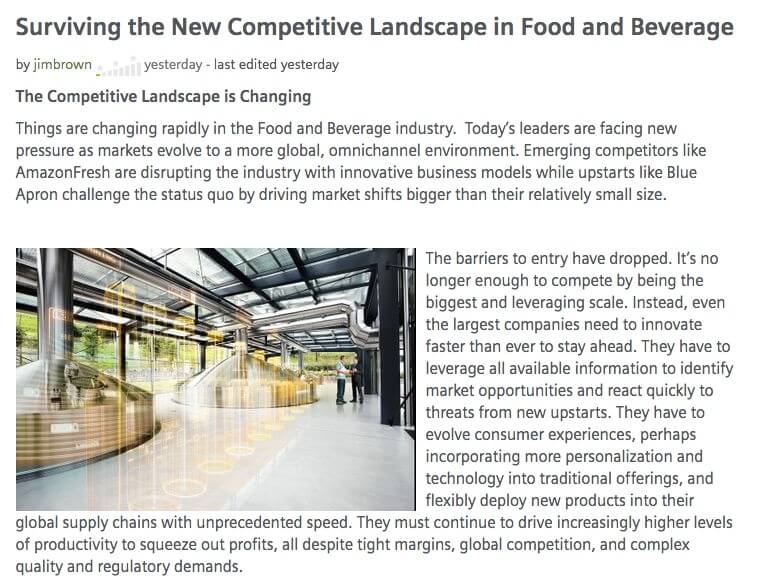 For the rest of the series, please see:
R&D Enters the Digital Age
Producing Food and Beverages in the Digital Age
The Analytics Opportunity for Food & Beverage in the Digital Age
[post_title] => Digitalization in Food and Beverage (guest post)
[post_excerpt] =>
[post_status] => publish
[comment_status] => open
[ping_status] => open
[post_password] =>
[post_name] => dig-fb
[to_ping] =>
[pinged] =>
[post_modified] => 2022-11-14 22:25:33
[post_modified_gmt] => 2022-11-15 03:25:33
[post_content_filtered] =>
[post_parent] => 0
[guid] => http://tech-clarity.com/?p=6260
[menu_order] => 0
[post_type] => post
[post_mime_type] =>
[comment_count] => 0
[filter] => raw
)
)
[post_count] => 20
[current_post] => -1
[before_loop] => 1
[in_the_loop] =>
[post] => WP_Post Object
(
[ID] => 6466
[post_author] => 2
[post_date] => 2017-11-29 16:24:42
[post_date_gmt] => 2017-11-29 21:24:42
[post_content] => Join Tech-Clarity's Jim Brown in a lively discussion with Planview NPD Evangelist Carrie Nauyalis discussing how to effectively measure product innovation. The duo will discuss the pitfalls of measuring innovation based on prior performance, the top five measures companies can use to measure innovation capability, and what's needed to get started measuring innovation to improve outcomes.
For the rest of the series, please see:
R&D Enters the Digital Age
Producing Food and Beverages in the Digital Age
The Analytics Opportunity for Food & Beverage in the Digital Age
[post_title] => Digitalization in Food and Beverage (guest post)
[post_excerpt] =>
[post_status] => publish
[comment_status] => open
[ping_status] => open
[post_password] =>
[post_name] => dig-fb
[to_ping] =>
[pinged] =>
[post_modified] => 2022-11-14 22:25:33
[post_modified_gmt] => 2022-11-15 03:25:33
[post_content_filtered] =>
[post_parent] => 0
[guid] => http://tech-clarity.com/?p=6260
[menu_order] => 0
[post_type] => post
[post_mime_type] =>
[comment_count] => 0
[filter] => raw
)
)
[post_count] => 20
[current_post] => -1
[before_loop] => 1
[in_the_loop] =>
[post] => WP_Post Object
(
[ID] => 6466
[post_author] => 2
[post_date] => 2017-11-29 16:24:42
[post_date_gmt] => 2017-11-29 21:24:42
[post_content] => Join Tech-Clarity's Jim Brown in a lively discussion with Planview NPD Evangelist Carrie Nauyalis discussing how to effectively measure product innovation. The duo will discuss the pitfalls of measuring innovation based on prior performance, the top five measures companies can use to measure innovation capability, and what's needed to get started measuring innovation to improve outcomes.
 Register for the November 30th webcast now, sponsored by Planview (free of charge, registration required).
[post_title] => Top 5 Metrics to Stop Measuring Innovation in the Rearview Mirror (webcast)
[post_excerpt] =>
[post_status] => publish
[comment_status] => open
[ping_status] => open
[post_password] =>
[post_name] => innovation-metrics
[to_ping] =>
[pinged] =>
[post_modified] => 2022-11-14 22:26:53
[post_modified_gmt] => 2022-11-15 03:26:53
[post_content_filtered] =>
[post_parent] => 0
[guid] => http://tech-clarity.com/?p=6466
[menu_order] => 0
[post_type] => post
[post_mime_type] =>
[comment_count] => 0
[filter] => raw
)
[comment_count] => 0
[current_comment] => -1
[found_posts] => 802
[max_num_pages] => 41
[max_num_comment_pages] => 0
[is_single] =>
[is_preview] =>
[is_page] =>
[is_archive] =>
[is_date] =>
[is_year] =>
[is_month] =>
[is_day] =>
[is_time] =>
[is_author] =>
[is_category] =>
[is_tag] =>
[is_tax] =>
[is_search] =>
[is_feed] =>
[is_comment_feed] =>
[is_trackback] =>
[is_home] => 1
[is_privacy_policy] =>
[is_404] =>
[is_embed] =>
[is_paged] =>
[is_admin] =>
[is_attachment] =>
[is_singular] =>
[is_robots] =>
[is_favicon] =>
[is_posts_page] =>
[is_post_type_archive] =>
[query_vars_hash:WP_Query:private] => 2c151c8db64ca9aa6627995999dd4c2d
[query_vars_changed:WP_Query:private] => 1
[thumbnails_cached] =>
[allow_query_attachment_by_filename:protected] =>
[stopwords:WP_Query:private] =>
[compat_fields:WP_Query:private] => Array
(
[0] => query_vars_hash
[1] => query_vars_changed
)
[compat_methods:WP_Query:private] => Array
(
[0] => init_query_flags
[1] => parse_tax_query
)
[query_cache_key:WP_Query:private] => wp_query:56cf8f7fb304f175f2cffbb4e39cde06:0.15412400 17646548120.16660600 1764654812
)
Register for the November 30th webcast now, sponsored by Planview (free of charge, registration required).
[post_title] => Top 5 Metrics to Stop Measuring Innovation in the Rearview Mirror (webcast)
[post_excerpt] =>
[post_status] => publish
[comment_status] => open
[ping_status] => open
[post_password] =>
[post_name] => innovation-metrics
[to_ping] =>
[pinged] =>
[post_modified] => 2022-11-14 22:26:53
[post_modified_gmt] => 2022-11-15 03:26:53
[post_content_filtered] =>
[post_parent] => 0
[guid] => http://tech-clarity.com/?p=6466
[menu_order] => 0
[post_type] => post
[post_mime_type] =>
[comment_count] => 0
[filter] => raw
)
[comment_count] => 0
[current_comment] => -1
[found_posts] => 802
[max_num_pages] => 41
[max_num_comment_pages] => 0
[is_single] =>
[is_preview] =>
[is_page] =>
[is_archive] =>
[is_date] =>
[is_year] =>
[is_month] =>
[is_day] =>
[is_time] =>
[is_author] =>
[is_category] =>
[is_tag] =>
[is_tax] =>
[is_search] =>
[is_feed] =>
[is_comment_feed] =>
[is_trackback] =>
[is_home] => 1
[is_privacy_policy] =>
[is_404] =>
[is_embed] =>
[is_paged] =>
[is_admin] =>
[is_attachment] =>
[is_singular] =>
[is_robots] =>
[is_favicon] =>
[is_posts_page] =>
[is_post_type_archive] =>
[query_vars_hash:WP_Query:private] => 2c151c8db64ca9aa6627995999dd4c2d
[query_vars_changed:WP_Query:private] => 1
[thumbnails_cached] =>
[allow_query_attachment_by_filename:protected] =>
[stopwords:WP_Query:private] =>
[compat_fields:WP_Query:private] => Array
(
[0] => query_vars_hash
[1] => query_vars_changed
)
[compat_methods:WP_Query:private] => Array
(
[0] => init_query_flags
[1] => parse_tax_query
)
[query_cache_key:WP_Query:private] => wp_query:56cf8f7fb304f175f2cffbb4e39cde06:0.15412400 17646548120.16660600 1764654812
)
All Results for "All"
Select the Right PLM Solution for BOM Management (webcast)
Jim Brown will moderate this IEEE webcast featuring Gentherm Director of Engineering Systems Marinko Lazanja and PTC’s Senior Director of Product Management Graham Birch. The webcast will share the importance of managing Bills of Material and product structures to avoid common inefficiencies and errors, but also to serve as the digital product backbone for the…
Selecting the Right Requirements Management Solution (webcast)
Listen to Christopher Rösner, General Requirements Manager at e.GO mobile AG, Tech-Clarity’s Michelle Boucher, and Che Curnew, Senior Technical Sales Specialist at PTC discuss the benefits of a better approach to requirements management. This event is an interactive interview to share different perspectives and experiences on requirements management. The discussion includes topics such as: How a Requirements Management solution can help…
BOM Transformation: How to Bring Service in to the Product Lifecycle (webcast)
Listen to Airbus Helicopters’ Nicolas De Mauroy, PTC’s Service Practice Lead Keith Garguilo, and Tech-Clarity’s Michelle Boucher, discuss how to improve the quality of the information made to service technicians by using the engineering BOM to produce the service BOM. By watching this event, you will learn about: The capabilities needed to transform EBOMs into SBOMs….
Close the Engineering Skills Gap (survey findings)
Close the Engineering Skills Gap:Prepare New Graduates to Be Real-World Ready shares new research on the gap between the skills graduating engineers have and skills companies would like to see. The research examines the evolving needs of the engineering department. The results reveal that engineering departments expect to grow so we will need more engineers. On top of that,…
How to Beat Your Competition in Product Development (infographic)
This infographic shares our research on how Top Performing companies achieve better NPDI performance than their competitors, excelling at revenue growth, margin expansion, and delivering innovative products. The infographic starts by providing a graphical view of the unfortunate truth about new product development, companies miss their quality, cost, requirements, regulatory compliance, project budget, and time…
Accelerating your Business & Reducing Complexity with the Cloud (panel discussion)
Tech-Clarity’s Jim Brown hosted a panel discussion at the recent Dassault Systèmes 3DEXPERIENCE Forum in Florida. The participants shared their perspectives on the cloud and their experience moving PLM to the cloud using the 3DEXPERIENCE Platform. Participants include: Kavi Parupally, Senior Director of Business Apps, Rockwell Collins Javier Glatt, CEO, CADMakers, Inc. Jeff Walters, VP…
Selecting a Solution to Manage Service Information (guest post)
In this PTC guest post, How to Select a Service Information Management Solution Michelle Boucher introduces some of the business advantages achieved by investing in service. The post outlines what is driving investments in service for 2017/18. It also looks at the top initiatives Top Performing companies use to support their goals for 2017/18. The post also touches on…
Analytics for Food and Beverage in the Digital Age (guest post)
Jim Brown provided a guest post to the Siemens PLM Community blog discussing how analytics can unlock new value for CPG and Food & Beverage companies. The post shares how big data analytics can uncover hidden relationships and create valuable insights from the vast amounts of data available to today’s food companies. It offers examples…
Composite Trends in the A&D Industry (survey findings)
Composite Trends in the A&D Industry: Identifying Opportunities to Save Cost and Time reveals survey findings on design and manufacturing trends for composites in the Aerospace & Defense industry. The research examines two areas that can be a source for bottlenecks when working with composites: springback and manufacturing planning. The report details best practices to…
Medical Devices in a Digital World (podcast)
Listen to Michelle Boucher discuss trends in the Medical Device Industry in this 17 minute podcast, Medical Devices in a Digital World. This podcast is episode 8 of The Connected Engineer series with Gavin Quinlan. In this episode, Michelle explains some of the top challenges facing medical device companies. She also shares advice on how to overcome them….
The How-to Guide for Adopting Model Based Definition (MBD)
The How-to Guide for Adopting Model Based Definition (MBD) reveals advice and best practices for implementing MBD. The guide explains why 89% of companies are happy they made the transition and benefits they enjoy as a result. The hardest part of adopting MBD is overcoming the cultural resistance to change. The guide identifies what other companies have…
Producing Food and Beverages in the Digital Age (guest post)
Jim Brown contributed a guest post to the Siemens PLM Community blog discussing how digitalization impacts the production of consumer packaged goods such as food and beverages. Digital enterprise in the food and beverage industry opens up a number of opportunities to improve manufacturing productivity and agility, all while maintaining or improving cost and quality….
Choosing Cost versus Quality in CPG (infographic)
This infographic shares survey results about quality and cost management in the Consumer Packaged Goods industry. It visually communicates the results of our research that shows how Top Performing CPG companies are able to achieve better quality and better cost of quality, without trading one for the other. The research shares the methods these leading…
Innovation Platforms are the Operating Systems for the Digital Enterprise (guest post)
Jim Brown contributed a guest post, Innovation Platforms – the Operating System for the Digital Enterprise, on the value of innovation platforms published in the Dassault Systèmes’ Navigate the Future blog. The post shares the value an integrated platform of solutions provides to engineers, the enterprise, and toward achieving digital transformation. The post also covers…
Five Ways Shape Search Drives Business Value (eBook)
Five Ways Shape Search Drives Business Value shares the shortcomings of traditional search methodologies and how geometric search can complement them to drive new business value. The report includes some basics about shape search, five tangible ways it can improve business performance, and an example of how to calculate the ROI of a shape search investment….
R&D Enters the Digital Age (guest post)
Jim Brown contributed a guest post to the Siemens PLM Community blog discussing how R&D in the food and beverage industry can step up to the digital age to combat smaller, innovative companies that embrace the digital enterprise. This is the first of several posts that drill down on Surviving the New Competitive Landscape in Food…
Selecting the Right PLM Software for Medical Device Engineering (webcast)
Listen to Tech-Clarity’s Michelle Boucher, Mark Turner from Alcon Labs (Novartis), and Swapan Jha from PTC have a discussion on the right software solution for medical device engineering. The discussion featured an interactive discussion between the panelists coving topics such as: Challenges facing medical device manufacturers. Why to consider the complete product lifecycle with respect…
Managing Requirements: A Prerequisite to Designing for the IoT (Webcast)
Listen to Steve Partridge, Sr. Go To Market Solution Specialist for PTC, and Tech-Clarity’s Michelle Boucher discuss the benefits of improving how requirements are managed, especially to support your IoT strategy. The discussion includes topics such as: How best practices for requirements management provide visibility into design decisions, changes, and tests Considerations to manage people, process and technology to make your…
Digitalization in Food and Beverage (guest post)
Jim Brown contributed a guest post to the Siemens PLM Community blog discussing the opportunity for food and beverage companies to leverage digitalization and the digital enterprise to combat market disruption from new, innovate companies that are challenging current industry leaders. The post offers several ways that consumer packaged goods (CPG) companies can get started…
